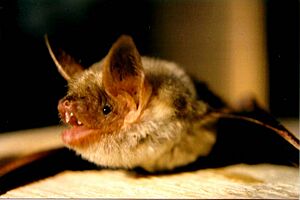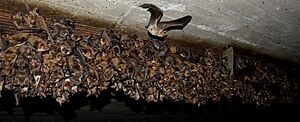Greater mouse-eared bat facts for kids
Quick facts for kids Greater mouse-eared bat |
|
|---|---|
 |
|
| Conservation status | |
| Scientific classification | |
| Genus: |
Myotis
|
| Species: |
myotis
|
 |
|
| Distribution | |
The greater mouse-eared bat (Myotis myotis) is a type of bat found in Europe. It belongs to a bat family called Vespertilionidae.
Contents
About the Greater Mouse-Eared Bat
The greater mouse-eared bat is a large bat. It has a long, wide nose and big, long ears. Its back is brown or reddish-brown. Its belly is a dirty white or beige color. A small part of its ear, called the tragus, is about half the size of the ear itself. Most bats of this species have a small black tip on their tragus. Their wing membranes are brownish.
This bat is quite large for its group, the Myotis genus. It can weigh up to 45 grams (1.6 oz). From head to tail, it measures 8 to 9 cm. This makes it a bit bigger than a house mouse. It is one of the largest bats in Europe. Its wingspan can reach 40 cm. Its forearm is about 6 cm long, and its tail is 4 to 5 cm long. These bats usually live for 3 to 4 years. However, some have lived as long as 14 years!
Where These Bats Live
The greater mouse-eared bat lives all over Europe. You can find them in most European countries. But they are not found in Denmark, Latvia, Estonia, Finland, or the Scandinavian Peninsula. They also live on many islands in the Mediterranean Sea. These include Sicily, Malta, and the Gymnesian Islands.
In the Middle East, Myotis myotis has been seen in Turkey, Israel, Syria, Jordan, and Lebanon. It might also live in the United Kingdom.
In the Balearic Islands, these bats live on Mallorca and Menorca. They are the most common bat species on Mallorca. Some caves there have huge groups of 200, 400, or even 500 bats. They are also very common in Spain and Portugal and France.
During the 1900s, this bat was very rare in Great Britain. It was only found in southern England. The places where they used to sleep through winter became empty. People thought the species had disappeared from Great Britain. But in recent years, a few bats have been found. This suggests that a group might still be there. Or, new bats might have come from mainland Europe.
In 2012, a special project started. It was called the LIFE-Nature project. Its goal was to protect thousands of greater mouse-eared bats. These bats live in the Gola della Rossa and Frasassi Nature Park in Italy.
How Greater Mouse-Eared Bats Behave
Like other bats in its family, the greater mouse-eared bat eats insects. It eats many different arthropods. But it hunts differently from many other bats. It does not catch prey while flying using echolocation. Instead, it finds its food on the ground. It listens for sounds made by insects. These include carabid beetles, other beetles, and large moths. It also eats centipedes and spiders. It uses echolocation mostly to know where it is going. But it does make ultrasound calls when it gets close to its prey.
Myotis myotis hunts in open forests with trees that lose their leaves. They also hunt at the edges of forests and in pastures. They usually sleep underground all year. But in Northern Europe, they also sleep in attics and lofts of buildings. Sometimes, small groups live in trees. On Mediterranean islands like Mallorca, colonies usually have up to 500 bats. But in mainland Europe, some groups have over 4,500 bats! They are known to share their roosts with other bats. These include the long-fingered bat and the common bent-wing bat. In mainland Europe, these bats can travel far in spring. Some travel up to 200 km. But most only travel about 10 km.
Reproduction and Life Cycle
Like most vesper bats, female greater mouse-eared bats are a little bigger than males. This is called sexual dimorphism. Mating happens in the autumn. Females give birth to their young between May and June. Each female usually has 1 or 2 babies. The mothers carry their pups for about 45 days. During this time, the females form special "nursery colonies." Males are not allowed in these groups.
The sounds these bats use for echolocation are very high-pitched. Their frequencies are between 22 and 86 kHz. Most of their energy is at 37 kHz. Each sound lasts about 6.0 milliseconds.



